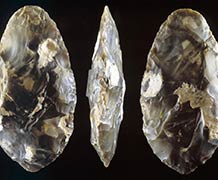
Acheulean hand axe
Complex cognition shaped the Stone Age hand axe
New research has shown that the ability to make a Stone Age hand axe depends on complex cognitive control and memory. The recently published results knock another chip off theories that pre-historic hand axes are simple tools that don’t involve complex functions of the brain made by ape-men just banging rocks together.
University of Exeter Archaeologist Professor Bruce Bradley co-authored the research with Emory University (USA) and Aix-Marseille University (France) colleagues, which highlights how making stone tools provide some of the most abundant evidence of human behavioural change over time.
As part of the study, a group of Archaeology students from the University of Exeter were trained in making stone tools from the Lower Palaeolithic period. The stone tools were shaped by striking a stone with a piece of bone, antler or another stone, a skill known as ‘knapping’. Researchers assessed the skill level of the students with fMRI (Magnetic Resonance Imaging) brain scans and a series of evaluations relating to the process of making stone tools.
Experimental archaeologist at Emory University and co-leader of Leverhulme Trust funded Learning To Be Human Project, Dietrich Stout said:“The skill of making a prehistoric hand axe is more complicated and nuanced than many people realise. For the first time, we’ve shown a relationship between the degree of prefrontal brain activity, the ability to make technical judgements, and success in actually making stone tools. The findings are relevant to ongoing debates about the origins of modern human cognition, and the role of technological and social complexity in brain evolution across species.”
The earliest known tools are simple Oldowan stone flakes which date back to 2.6 million years ago and are relatively easy to make in comparison to the later Acheulean hand axe, which goes back more than 500,000 years and is harder to master as a result of its complex symmetrical design. The archaeology students in the experiment were taught how to make both sets of tools by expert knapper, Professor Bradley. Most of the hand axes produced by the modern hands and minds of the students weren’t up to the high standards of the Stone Age.
When monitoring the students’ understanding and ability the researchers wanted to tease out and compare what parts of the brain were most actively involved in the stone technologies, particularly the role of motor control verses strategic thinking.
Professor Bradley explained: “Making an Acheulean hand axe is hard to master due to its complexity and symmetry requiring abstract, sequential strategic thinking. This type of thinking is associated with activity in the prefrontal cortex, which allows one to project what’s going to happen and use this to guide subsequent actions. Our experiments with the students showed that when monitoring their brains there was increased activity in the prefrontal cortex, showing that making tools requires complicated thinking.”
The ‘Cognitive Demands of Lower Paleolithic Toolmaking’ research was recently published in Plos One.
A previous study by the same researchers showed that learning to make stone tools creates structural changes in fibre tracts of the brain connecting the parietal and frontal lobes, and that these brain changes correlated with increases in performance.
Date: 20 April 2015
